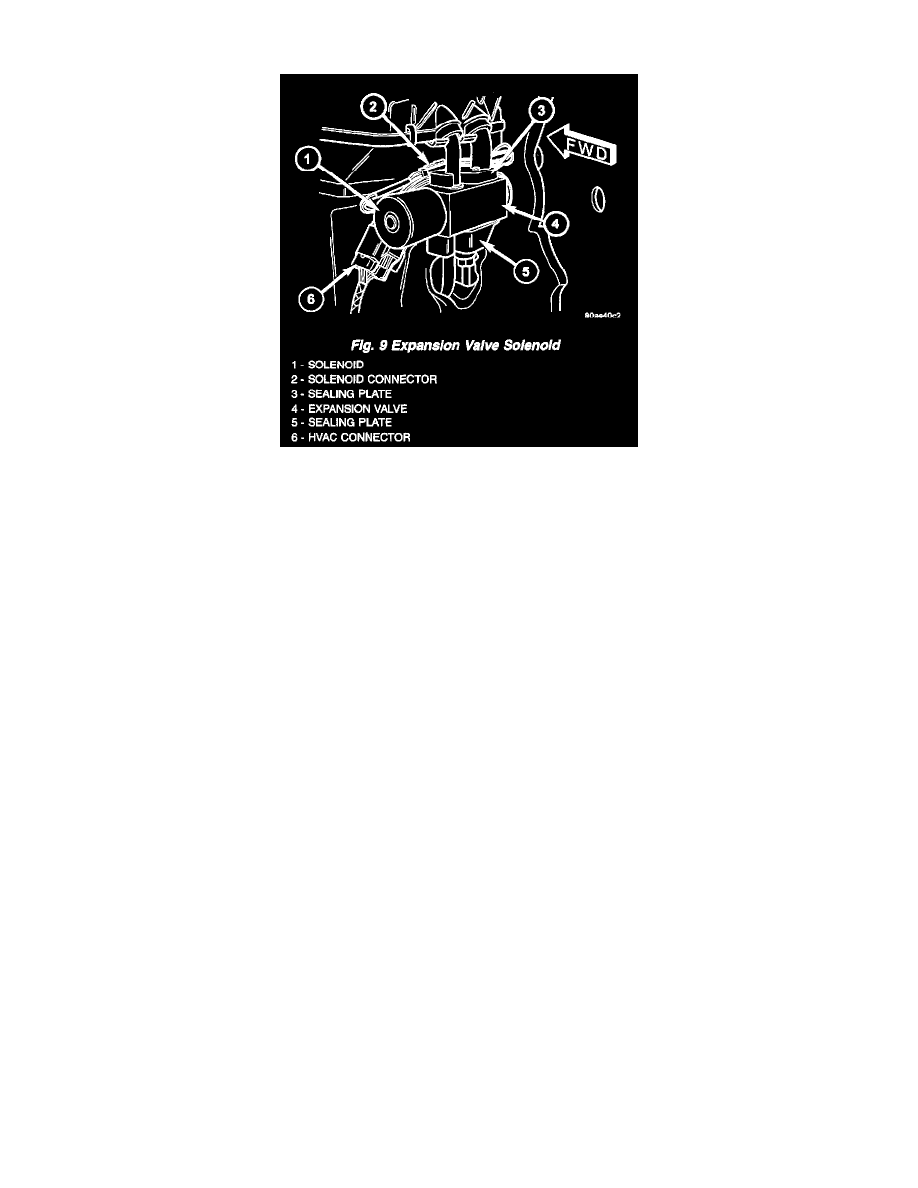Voyager L4-2.4L VIN B (2001)

Expansion Valve: Description and Operation
Fig.9 Expansion Valve Solenoid
EXPANSION VALVE SOLENOID
A rear expansion valve solenoid is used on models equipped with the optional Automatic Temperature Control (ATC) heating and air conditioning
system. The solenoid is located on the inboard side of the rear expansion valve where it is concealed by the quarter inner trim panel behind the
right rear wheel house. A short two-wire pigtail harness connects the solenoid to the vehicle electrical system through a take out and connector of
the rear HVAC wire harness. The solenoid is integral to the rear expansion valve. The rear expansion valve solenoid cannot be adjusted or
repaired and, if faulty or damaged, the rear expansion valve unit must be replaced.
The rear expansion valve solenoid is designed to control the flow of refrigerant to the rear evaporator. The solenoid receives fused battery current
through the rear blower motor relay on a fused rear blower motor relay output circuit, and receives a ground feed from the front ATC heater-A/C
control module on a TXV solenoid feed circuit. The front ATC heater-A/C control module is programmed to control solenoid operation. When the
solenoid blocks refrigerant flow to the rear evaporator, the resulting increase in the refrigerant circulation rate between the condenser and the front
evaporator provides improved A/C cooling performance for the front seat occupants. The solenoid may be diagnosed using a DRB III scan tool.
Refer to the appropriate diagnostic information.
EXPANSION VALVE - FRONT
The front "H" valve-type Thermal Expansion Valve (TXV) is located at the dash panel between the liquid and suction lines, and the evaporator
coil. The assembly consists of an H-valve body and a thermal sensor. High-pressure, low temperature liquid refrigerant from the liquid line passes
through the expansion valve orifice, converting it into a low-pressure, low-temperature mixture of liquid and gas before it enters the evaporator
coil. The expansion valve is a factory calibrated unit and cannot be adjusted or repaired. If faulty or damaged, the expansion valve must be
replaced.
A mechanical sensor in the expansion valve control head monitors the temperature and pressure of the refrigerant leaving the evaporator coil
through the suction line, and adjusts the orifice size at the liquid line to let the proper amount of refrigerant into the evaporator coil to meet the
vehicle cooling requirements. Controlling the refrigerant flow through the evaporator ensures that none of the refrigerant leaving the evaporator is
still in a liquid state, which could damage the compressor. The thermo sensor measures refrigerant liquid temperature which is monitored by the
a/c control assembly.
EXPANSION VALVE - REAR
The rear "H" valve-type thermal expansion valve (TXV) is located at the rear of the rear heater-A/C unit housing between the evaporator line
extension and the evaporator coil. High-pressure, low temperature liquid refrigerant from the liquid line passes through the expansion valve
orifice, converting it into a low-pressure, low-temperature mixture of liquid and gas before it enters the evaporator coil. Models equipped with the
optional Automatic Temperature Control (ATC) system also have an electric solenoid that is located on the inboard side of and integral to the rear
expansion valve. The expansion valve is a factory calibrated unit and cannot be adjusted or repaired. If faulty or damaged, the expansion valve
must be replaced.
A mechanical sensor in the expansion valve control head monitors the temperature and pressure of the refrigerant leaving the evaporator coil
through the suction line, and adjusts the orifice size at the liquid line to let the proper amount of refrigerant into the evaporator coil to meet the
vehicle cooling requirements. Controlling the refrigerant flow through the evaporator ensures that none of the refrigerant leaving the evaporator is
